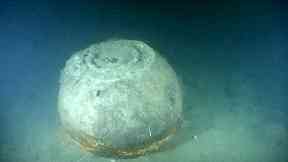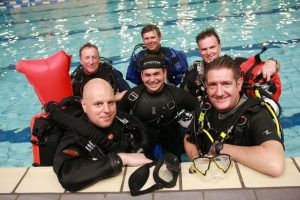Highball Bouncing Bomb Project
Some of you might be aware of my involvment in the Loch Striven Highball Project. Highballs were bouncing bombs developed by Barnes Wallis to destroy enemy ships. Their big brothers the ‘Upkeep’ bombs, were the ones used to destroy dams. ‘Upkeep’ were the bombs referenced in the famous Dambusters film.
The Highballs were never used in anger. Inert versions were tested at Loch Striven in Argyll during WW2, and many still lie at the bottom of the Loch today.

In 2010, Dr Iain Murray of Dundee University manged to gain funding for a small team of five divers to stay at Loch Striven for a week and search for the bombs. The team consisted of two military divers, one BSAC advanced diver, Phil Grigg Technical and me, a novice diver with 100 dives, twinset and camera.We also had the help of local fisherman Richard, who had previously dragged a few of the bombs up in his fishing gear.
We located a number of the Highballs after working through various methods. This included studying archival references, Richard’s boat sounder, dive searches and transit location from 1940’s film footage. From this we worked out the general area of the target vessel and thus the potential pattern of distribution of the Highballs. At that time there was no funding to uplift a bomb for museum purposes.
Fast forward seven years, and Highball phase 2 is now on the go. This time a UK wide team is involved. We have eleven BSAC Divers, a Navy Recovery team and private sponsorship from NE company Subsea Tooling Services for ROV support. The project has been taken up and pushed forward by Mark Paisey of East Cheshire SAC . Mark is also the NW Regional BSAC Coach. He is in the fascinating position of having experienced life from not only being a diver, but also from the air as an RAF pilot.

For Highball phase two, Mark’s team will be surveying, mapping and documenting the site by side scan, diving and photography. Dive depths are between between 32 and 60m and two intact Highballs will be identified for upilft. With the help of the professional recovery team from the Navy, the bombs will see their first light of day in over seventy years. The Highballs will be archaeologically preserved and put on show in two museums. This gives the general public the opportunity to see this very unique part of our technological history.
Needless to say I am thrilled to be part of this project again. Having already experienced this location, I am prepared for the unforgiving, dark and silty atmosphere of Loch Striven.
Mark was on BBC Radio Scotland and his interview can be found at this link from 1:22:20:
http://www.bbc.co.uk/programmes/b08spjjj